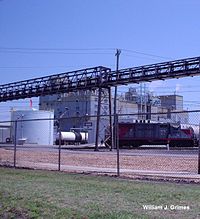- Chemical tank
-
BASF Chemical Plant Portsmouth Site in the West Norfolk area of Portsmouth, Virginia. The plant is served by the Commonwealth Railway.

Chemical tanks are storage containers for chemicals. They come in a variety of sizes and shapes, and are used for static storage, mixing, and transport of both raw materials and finished chemical products.
Design
"Chemical tanks" represent the first line of control for some of the most aggressive chemicals, control consists of selecting the "chemical tank" most able to cope with the application parameters and prevents the negative impact of the chemical both to humanity and the environment.
A "Chemical tank" will of necessity be made of a material resistant to that chemical stored, it will also be designed to operate within the mechanical parameters (pressure and temperature, erosive & corrosive) of it application parameters. Compatibility is a watch word for chemical tank design. Chemical tanks/containers may be impacted by; heat, cold, vacuum, pressure and the aggressive nature (acidic - caustic) of the chemical to be stored.
There are short term and long term goals associated with the engineering and specification of the correct materials for a chemical container. While economic considerations are a factor, the design of chemical storage containers and how they may impact the environment is crucial.
Typically, there will be a chemical profile and information report known as a "MSDS" (Material Safety Data Sheet) which is provided by most chemical manufacturers or distributors and should be the starting point for chemical tank design. Chemical tanks should be designed in conjunction with the chemical manufacturer, providing some historic experience regarding tank materials compatibility to the chemical.
A few design tips of successful additions that promote long term security of the chemical tank system.
a. Expansion joints are devices that isolate the stress forces that would otherwise be transferred to the chemical tank, i.e. vibration, torsional and tangential movement, expansion and contraction originating with the tank itself. The expansion joint absorbs stress from the tank wall, process connections and piping.
b. Emergency venting by "Rupture disc", a sacrificial device that prevents vacuum or pressure from destroying the chemical tank and release uncontrolled chemicals into the environment. Located on the tank top, the device vents air into or out of the chemical tank.
c. Valves with lockout capability prevent unauthorized movement of liquids from chemical tanks, compatibility is always critical.
d. Extreme attention to tank heaters and their negative impact on tanks materials, tank coatings and process liquids, (example; heaters have caused coating failure (melting), tank wall failure and changed the chemical compound being stored.
Venting is crucial Chemical tank venting and overflow control should be given consideration, as loading the tank requires venting air out of the tank, and unloading the tank requires air to fill the space voided by the removal of the stored chemical.
Foundations for the tank, protect the container from damage and maintain relative relationships between tank and plumbing (pumps, pipe, valves and tank fittings)
Secondary containment provides for 110% capacity of largest tank in containment area. Containment prevents escape of chemicals into the environment, by providing a holding area for chemicals that may leak from the tank farm.
References
NACE - National Association of Corrosion Engineers http://www.nace.org/nace/index.asp
NACD - National Association of Chemical Distributors http://www.nacd.com/
AICHE - American Institute Of Chemical Engineers http://www.aiche.org/index.aspx
ASME - American Society of Mechanical Engineers http://www.asme.org/
Categories:- Unit operations
Wikimedia Foundation. 2010.

